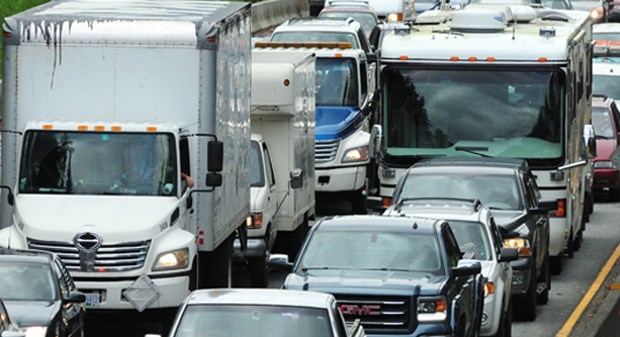I was stuck in a traffic jam on Queens the other day…
You heard that right.
A traffic jam.
On Queens.
I kid you not; it was bumper-to-bumper from the Edgemont Boulevard fruit stand to the Delbrook tennis courts. Who were all those people and why were they clogging up my nice leafy neighbourhood street with their exhaust and window-rattling rap music?
I’ve never seen anything like it, and come to think of it, I’ve never seen anything like the traffic on the Upper Levels at rush hour, especially heading east in the evening, and I’ve never seen anything like the traffic on Marine Drive, any time of the day.
So, while I was in the traffic jam on Queens I had plenty of time to think about all this congestion and wonder what causes it.
If I’m looking for help, there are as many theories as there are cars in front of me waiting to turn left.
A lot of people think that increased density is the problem. North Vancouver District Councillor Lisa Muri is so concerned about the district’s recent enthusiasm for density she wants to put the brakes on development until we understand the impact of all these people and their cars.
Of course, density is the urban planning trend du jour, offered as the solution for all our woes. Density is more efficient than suburban sprawl, which cuts into our wondrous North Shore wilderness and comes with prohibitive infrastructure costs — more sewer and water pipes, more roads, more bridges.
And that leads to higher taxes, and nobody wants to go there.
Density also holds out the promise of affordable housing. When the price of a single-family three-bedroom house, white picket fence included, is over a million bucks, it’s time to build condos that people can actually afford, sort of. (There are those who would argue that two-thirds of a million bucks for 1,000 square feet is affordable in a parallel universe maybe. But I digress.)
Finally, density is easier. These days, it’s almost impossible to assemble the land to build 100 single-family dream units, where as you can build 100 condos and get started on the next 100 before you can say “rezone it”!
The problem is that density comes with its own problem: more people. More people come with more cars, and the collective term for more cars is (wait for it) traffic.
Don’t get me wrong. I buy into the idea that density is good for us. It seems ludicrous to even think about chewing up what’s left of the rain forest to build mini-estates for the notorious million people who are all planning to move here by 2030. In fact, not only is it ludicrous, it’s impossible. And even if the million people go somewhere else (real estate’s cheaper in Calgary these days), single-family homes with lawns are environmental atrocities.
Condo king Bob Rennie says he doubts another single-family dwelling will ever be built in Vancouver — apart from infill — and that’s just as likely on the North Shore.
So, as I sat in my car on Queens, I saw the future of North Vancouver.
I’m just a little worried that I might not get there because I’ll be stuck in traffic.
Journalist and communications consultant Paul Sullivan has been a North Vancouver resident since the fall of the Berlin Wall and the rise of Madonna. He can be reached via email at: [email protected].
What are your thoughts? Send us a letter via email by clicking here or post a comment below.



